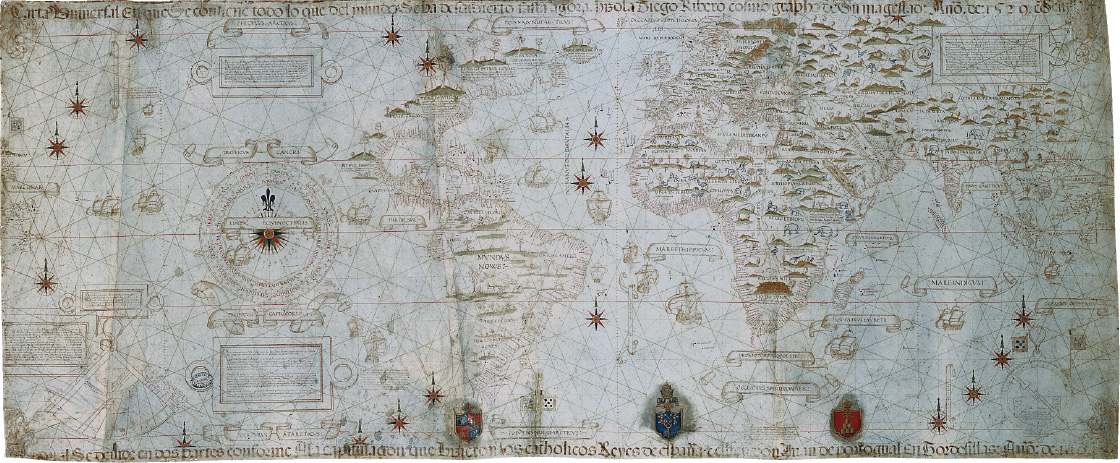Later Explorers
Treaty of Tordesillas The 1494 agreement giving Spain everything west of an imaginary line drawn down the Atlantic and giving Portugal everything to the east.
The Florentine navigator Amerigo Vespucci (veh-SPOO-chee; 1454–1512) realized what Columbus had not. Writing about his discoveries on the coast of modern-day Venezuela, Vespucci was the first to describe America as a continent separate from Asia. In recognition of Amerigo’s bold claim, the continent was named for him.
To settle competing claims to the Atlantic discoveries, Spain and Portugal turned to Pope Alexander VI. The resulting Treaty of Tordesillas (tor-duh-SEE-yuhs) in 1494 gave Spain everything to the west of an imaginary line drawn down the Atlantic and Portugal everything to the east. This arbitrary division worked in Portugal’s favor when in 1500 an expedition led by Pedro Alvares Cabral, en route to India, landed on the coast of Brazil, which Cabral claimed as Portuguese territory.

Spain had not given up the search for a western passage to Asia. In 1519 Charles V of Spain commissioned Ferdinand Magellan (1480–1521) to find a direct sea route to the spices of the Moluccas, islands off the southeast coast of Asia. Magellan sailed southwest across the Atlantic to Brazil, and after a long search along the coast he located the treacherous strait off the southern tip of South America that now bears his name (see Map 16.2). After passing through the strait, his fleet sailed up the west coast of South America and then headed west into the Pacific toward the Malay Archipelago. Some of these islands were conquered in the 1560s and named the Philippines for Philip II of Spain.
Terrible storms, disease, starvation, and violence haunted the expedition, and only one of Magellan’s five ships returned to Spain. Magellan himself was killed in a skirmish in the Philippines. In 1522 the sole remaining ship, with only eighteen men aboard, returned to Spain, having traveled from the east by way of the Indian Ocean, the Cape of Good Hope, and the Atlantic. The voyage—the first to circumnavigate the globe—had taken close to three years.
Despite the losses, this voyage revolutionized Europeans’ understanding of the world by demonstrating the vastness of the Pacific. Magellan’s expedition also made Spain rethink its plans for overseas commerce and territorial expansion. Clearly, the westward passage to the Indies was too long and dangerous for commercial purposes. Thus Spain soon abandoned the attempt to oust Portugal from the Eastern spice trade and concentrated on exploiting its New World territories.
The English and French also set sail across the Atlantic during the early days of exploration, in their case to search for a northwest passage to the Indies. In 1497 John Cabot (ca. 1450–1499), a Genoese merchant living in London, discovered Newfoundland. The next year he returned and explored the New England coast. These forays proved futile, and at that time the English established no permanent colonies in the territories they explored. Early French exploration of the Atlantic was equally frustrating. Between 1534 and 1541 Frenchman Jacques Cartier (1491–1557) made several voyages and explored the St. Lawrence region of Canada, searching for a passage to the wealth of Asia. When this hope proved vain, the French turned to a new source of profit within Canada itself: trade in beavers and other furs. French fisherman also competed with the Spanish and English for the teeming schools of cod they found in the Atlantic waters around Newfoundland.